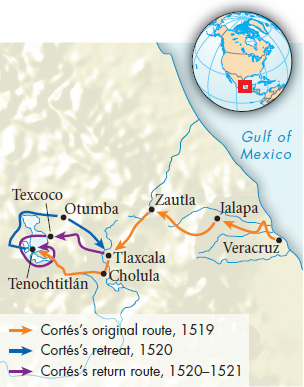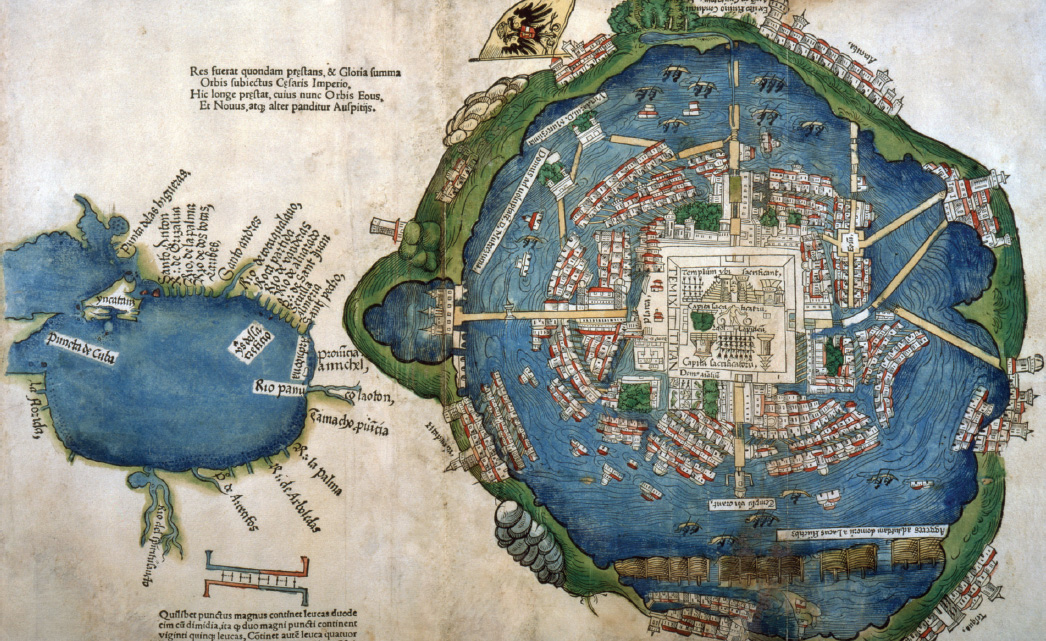A History of Western Society: Printed Page 441
A History of Western Society, Value Edition: Printed Page 453
Spanish Conquest in the New World

In 1519, the year Magellan departed on his worldwide expedition, the Spanish sent an exploratory expedition from their post in Cuba to the mainland under the command of the brash and determined conquistador Hernando Cortés (1485–1547). Accompanied by six hundred men, sixteen horses, and ten cannon, Cortés was to launch the conquest of the Mexica Empire. Its people were later called the Aztecs, but now most scholars prefer to use the term Mexica to refer to them and their empire.
The Mexica Empire was ruled by Montezuma II (r. 1502–1520) from his capital at Tenochtitlán (tay-nawch-teet-LAHN), now Mexico City. Larger than any European city of the time, it was the heart of a sophisticated civilization with advanced mathematics, astronomy, and engineering; a complex social system; and oral poetry and historical traditions.
Cortés landed on the coast of the Gulf of Mexico on April 21, 1519. The Spanish camp was soon visited by delegations of unarmed Mexica leaders bearing lavish gifts and news of their great emperor. (See “Primary Source 14.3: Doña Marina Translating for Hernando Cortés During His Meeting with Montezuma.”) Impressed with the wealth of the local people, Cortés soon began to exploit internal dissension within the empire to his own advantage. The Mexica state religion necessitated constant warfare against neighboring peoples to secure captives for religious sacrifices and laborers for agricultural and building projects. Conquered peoples were required to relinquish products of their agriculture and craftsmanship to pay tribute to the Mexica state through their local chiefs.
Cortés quickly forged an alliance with the Tlaxcalas (Tlah-scalas) and other subject kingdoms, which chafed under the tribute demanded by the Mexica. In October a combined Spanish-Tlaxcalan force occupied the city of Cholula, the second largest in the empire and its religious capital, and massacred many thousands of inhabitants. Strengthened by this display of power, Cortés made alliances with other native kingdoms. In November 1519, with a few hundred Spanish men and some six thousand indigenous warriors, Cortés marched on Tenochtitlán.

Montezuma refrained from attacking the Spaniards as they advanced toward his capital and welcomed Cortés and his men into Tenochtitlán. Historians have often condemned the Mexica ruler for vacillation and weakness. Certainly other native leaders did attack the Spanish. But Montezuma relied on the advice of his state council, itself divided, and on the dubious loyalty of tributary communities. Historians have questioned one long-standing explanation, that he feared the Spaniards as living gods. This idea is mostly found in texts written after the fact by Spanish missionaries and their converts, who used it to justify and explain the conquest. Montezuma’s hesitation proved disastrous. When Cortés took Montezuma hostage and tried to rule the Mexica through the emperor’s authority, Montezuma’s influence over his people crumbled.
In May 1520 Spanish forces massacred Mexica warriors dancing at an indigenous festival. This act provoked an uprising within Tenochtitlán, during which Montezuma was killed. The Spaniards and their allies escaped from the city and began gathering forces against the Mexica. One year later, in May 1521, Cortés laid siege to Tenochtitlán at the head of an army of approximately 1,000 Spanish and 75,000 native warriors.13 Spanish victory in August 1521 resulted from its superior technology and the effects of the siege and smallpox. After the defeat of Tenochtitlán, Cortés and other conquistadors began the systematic conquest of Mexico. Over time, a series of indigenous kingdoms gradually fell under Spanish domination, although not without decades of resistance.
More surprising than the defeat of the Mexica was the fall of the remote Inca Empire. Perched more than 9,800 feet above sea level, the Incas were isolated from North American indigenous cultures and knew nothing of the Mexica civilization or its collapse. Like the Mexica, the Incas had created a civilization that rivaled that of the Europeans in population and complexity. To unite their vast and well-fortified empire, the Incas built an extensive network of roads, along which traveled a highly efficient postal service. The imperial government, with its capital in the city of Cuzco, taxed, fed, and protected its subjects.
At the time of the Spanish invasion the Inca Empire had been weakened by an epidemic of disease, possibly smallpox. Even worse, the empire had been embroiled in a civil war over succession. Francisco Pizarro (ca. 1475–1541), a conquistador of modest Spanish origins, landed on the northern coast of Peru on May 13, 1532, the very day Atahualpa (ah-tuh-WAHL-puh) won control of the empire after five years of fighting. As Pizarro advanced across the steep Andes toward Cuzco, Atahualpa was proceeding to the capital for his coronation.
Like Montezuma in Mexico, Atahualpa was aware of the Spaniards’ movements. He sent envoys to invite the Spanish to meet him in the provincial town of Cajamarca. His plan was to lure the Spanish into a trap, seize their horses and ablest men for his army, and execute the rest. With an army of some forty thousand men stationed nearby, Atahualpa felt he had little to fear. Instead, the Spaniards ambushed and captured him, collected an enormous ransom in gold, and then executed him in 1533 on trumped-up charges. The Spanish now marched on the capital of the empire itself, profiting once again from internal conflicts to form alliances with local peoples. When Cuzco fell in 1533, the Spanish plundered immense riches in gold and silver.
As with the Mexica, decades of violence and resistance followed the defeat of the Incan capital. Struggles also broke out among the Spanish for the spoils of empire. Nevertheless, Spanish conquest opened a new chapter in European relations with the New World. It was not long before rival European nations attempted to forge their own overseas empires.